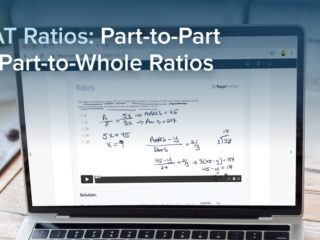Last Updated on October 8, 2023
While the subject “decimals” may seem bland and mundane, there are some pretty interesting ways the GMAT can test you on your knowledge of decimal numbers. Specifically, you may be tested on how to recognize whether a decimal (when converted from a fraction) will be either a terminating or repeating decimal. In fact, your ability to recognize the difference between the two could very likely help you on test day.
When you convert a fraction to decimal form, the fraction will convert to either a terminating decimal or a non-terminating, repeating decimal. Let’s discuss terminating decimals first.
KEY FACT:
When you convert a fraction to decimal form, the fraction will convert to either a terminating decimal or a non-terminating, repeating decimal.
Terminating Decimals
A terminating decimal has a finite number of digits after the decimal point. For example, 3.782 and 0.25 are terminating decimals. It’s easy to see when a decimal is a terminating decimal, but determining whether a given fraction will result in a terminating decimal may be more challenging. There are two requirements for a fraction to convert to a terminating decimal:
1) Ensure that the fraction is in its lowest terms and written in the form x/y, where x and y are integers and y is not equal to zero.
2) The denominator must break down to prime factors of only 2 and/or 5. If there are any other prime numbers in the denominator’s prime factorization, then the decimal will NOT terminate.
Let’s look at a few examples of fractions whose decimal equivalents terminate.
We see that each fraction’s denominator has prime factors that are only 2 or 5 or both. Note that the value of the numerator has no bearing on whether a fraction yields a terminating decimal.
KEY FACT:
If x and y are integers and y does not equal zero, x/y will convert to a terminating decimal if the denominator of the reduced fraction breaks down into prime factors of only 2 and/or 5.
Now, let’s discuss how to recognize a decimal that repeats rather than terminates.
Repeating Decimals
Now that we know how to recognize a terminating decimal, we can quickly determine how to recognize a non-terminating, repeating decimal. There are two requirements for a fraction to convert to a repeating decimal:
1) Ensure that the fraction is in its lowest terms and written in the form x/y, where x and y are integers and y is not equal to zero.
2) The denominator of the reduced fraction has at least one prime factor that is neither 2 nor 5.
Let’s look at a few examples of fractions that convert to non-terminating, repeating decimals.
KEY FACT:
If x and y are integers and y does not equal zero, x/y will convert to a repeating decimal if the denominator of the fraction, when in its most reduced form, has at least one prime factor that is neither 2 nor 5.
We now know how to tell whether a fraction will result in a terminating or a non-terminating, repeating decimal. Let’s practice with a couple of examples.
Example 1
Which of the following fractions will convert to a terminating decimal?
A. 1/7
B. 9/60
C. 12/45
D. 15/45
E. 20/30
Solution:
Recall that a fraction reduced to the lowest terms will convert to a terminating decimal if its denominator contains prime factors of only 2 and/or 5. Let’s consider each answer choice.
A. 1/7 is already reduced to lowest terms. Its denominator of 7 is a prime number other than 2 or 5, so 1/7 is not a terminating decimal. Eliminate choice A.
B. 9/60 reduces to 3/20. We can factor the denominator as 20 = 2² ⨉ 5. Since all the prime factors of the reduced denominator are either 2 or 5, we see that 9/60 is a terminating decimal. (In fact, its decimal equivalent is 0.15.)
Since we have found the answer choice that has a terminating decimal form, we can stop.
Answer: B
Example 2
Which of the following fractions will convert to the decimal that contains the greatest number of nonzero digits?
A. 7/25
B. 14/28
C. 6/60
D. 5/15
E. 4/20
Solution:
A fraction’s decimal representation will have an infinite number of nonzero digits if it is a non-terminating decimal. Recall that a fraction reduced to lowest terms whose denominator has a prime factor other than 2 or 5 will be a non-terminating, repeating decimal. Let’s consider each answer choice.
A. 7/25 is already in lowest terms. Its denominator factors to 25 = 5², having only 5 as a prime factor. Thus, this fraction will convert to a terminating decimal. Eliminate choice A.
B. 14/28 can be reduced to ½. The denominator of this reduced fraction is the prime number 2. Thus, this fraction will convert to a terminating decimal. Eliminate choice B.
C. 6/60 can be reduced to 1/10. Its denominator factors to 10 = 2 ⨉ 5, so 6/60 also converts to a terminating decimal. Eliminate choice C.
D. 5/15 can be reduced to 1/3. We see that the denominator contains a prime factor of 3, so this fraction is non-terminating and repeating. Thus, it has an infinite number of nonzero digits.
Note that we can stop here, as we have found what we are looking for. The decimal representation of the fraction 1/3 yields an infinite number of nonzero digits after the decimal point. No other fraction can have more digits in its decimal form.
Also, note that it was not necessary to evaluate each fraction’s decimal equivalent. This would have been a necessary step only if we had not found an answer choice that yielded a non-terminating and repeating decimal.
Answer: D
While terminating and repeating decimals may not be the most fascinating topics tested on the GMAT, they are easy to learn and apply. The rules that guide us to distinguish between fractions that do and do not give us terminating decimals are a simple application of prime number theory, and your knowledge of those rules may well come in handy on test day!
For some more helpful GMAT math tips, check out our article about how to improve your GMAT math score.




Nice explanation
Glad that you liked it!